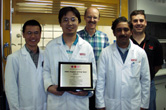A team of researchers led by a UNMC College of Pharmacy faculty member recently received recognition for its work in the discovery of a compound that shows promise in the development of a cheaper, more effective anti-malarial drug with fewer side effects. 
The Medicines for Malaria Venture (MMV), headquartered in Geneva, Switzerland, chose the UNMC-led project as the best and most successful of its 12 funded projects. UNMC is collaborating with researchers from Monash University in Australia, the Swiss Tropical Institute and F. Hoffmann-LaRoche in Switzerland. The team shares a three-year, $3.3 million grant provided by MMV.
Speaking at the European Federation of Pharmaceutical Industries Conference on Global Healthcare and Development, Christopher Hentschel, chief executive officer of MMV, announced that the team had been selected as the MMV partnership achieving the most promising research results in 2001 for its groundbreaking work.
Developing the next aspirin for malaria
“We have some very exciting compounds,” said Jonathan Vennerstrom, Ph.D., associate professor of pharmaceutical sciences at the UNMC College of Pharmacy and principal investigator of the grant. “We hope it’s the next aspirin for malaria.”
UNMC developed a unique class of compounds that is highly effective, long-lasting and acts rapidly in mouse models against the parasite that causes malaria in humans. UNMC’s role in the venture is to make the compounds, purify them and work with other team members who test the safety and potential of the compounds. The team hopes to begin clinical trials in humans within the next few years.
“This group has succeeded in taking the well established anti-malarial ‘warhead’ found in an ancient Chinese herbal remedy and has developed it into a chemical series that is now very drug-like and amenable to modern drug optimization techniques and to industrial scale-up,” said Simon Campbell, who chairs the MMV Expert Scientific Advisory Committee.
“In animal studies, these compounds essentially cure malaria with one dose. Compounds that have not yet progressed to clinical development are by definition high risk, and it will still take many years before the work delivers a registered drug, but the extraordinary progresses made by this group and the compelling animal data potentially herald a new class of anti-malarial drugs.”
MMV is supported by the Bill and Melinda Gates Foundation, ExxonMobil Corporation, the Global Forum for Health Research, the International Pharmaceutical Manufacturers Association, the Netherlands Ministry for Development Cooperation, the Rockefeller Foundation, the Swiss Agency for Development and Cooperation, the United Kingdom Department for International Development, the World Bank, the World Health Organization, Roll Back Malaria, and the UNDP/World Bank/WHO Special Programme for Research and Training in Tropical Diseases.
A distant killer?
Though now the malaria epidemic seems like a world away, in places like Africa, Asia, and Central and South America, the disease kills more than 1 million people each year, most of them children and pregnant women, according to the World Health Organization (WHO). In addition, an estimated 300 million to 500 million new cases of malaria are diagnosed each year. More than 90 percent of all malaria cases occur in Africa.
According to the U.S. Centers for Disease Control and Prevention, malaria could reemerge in the U.S. due to the malaria parasite building up resistance to current drugs, environmental changes and increased air travel. American travelers and military personnel who travel to countries where malaria is prevalent are at risk.
In the 1840s, malaria was a major cause of 600 deaths among Mormons living in Omaha’s Florence area. In 1914, an estimated 600,000 cases of malaria occurred in the United States. Today, malaria is rare in the U.S. due to urbanization, improved sanitation, housing, nutrition and living standards, as well as eradication of mosquitoes with insecticides beginning in the 1940s.
The UNMC team has identified several anti-malarial compounds in a new class of chemical structures. The WHO has called its work “spectacular.” The team also has applied for a patent on the compound.
Growing up in Ethiopia
Dr. Vennerstrom has been studying malaria for 17 years and became aware of the disease while growing up in Ethiopia while his parents taught at mission schools.
“With the exception of tuberculosis, malaria kills more people than any other infectious disease,” said Dr. Vennerstrom, who took anti-malarial drugs from the age of seven until he was 16. He and his parents, who are missionaries, lived in Addis Ababa, the highlands of Ethiopia, for nine years.
“Having had experience growing up in a country with malaria gives you a perspective and interest,” he said.
The disease, which takes an enormous toll in lives, medical costs and lost labor, is caused by a parasite that is transmitted by the bite of an infected Anopheles mosquito.
MMV, an international public and privately funded organization, was formed in 1999 to create a unique way for developing new anti-malarial drugs that may otherwise not be developed due to cost.
Photo: Left to right, Yuanqing Tang, Ph.D., Yuxiang Dong, Ph.D., Jonathan Vennerstrom, Ph.D., Srinivasa Cheruku, Ph.D. and Scott Alexander.